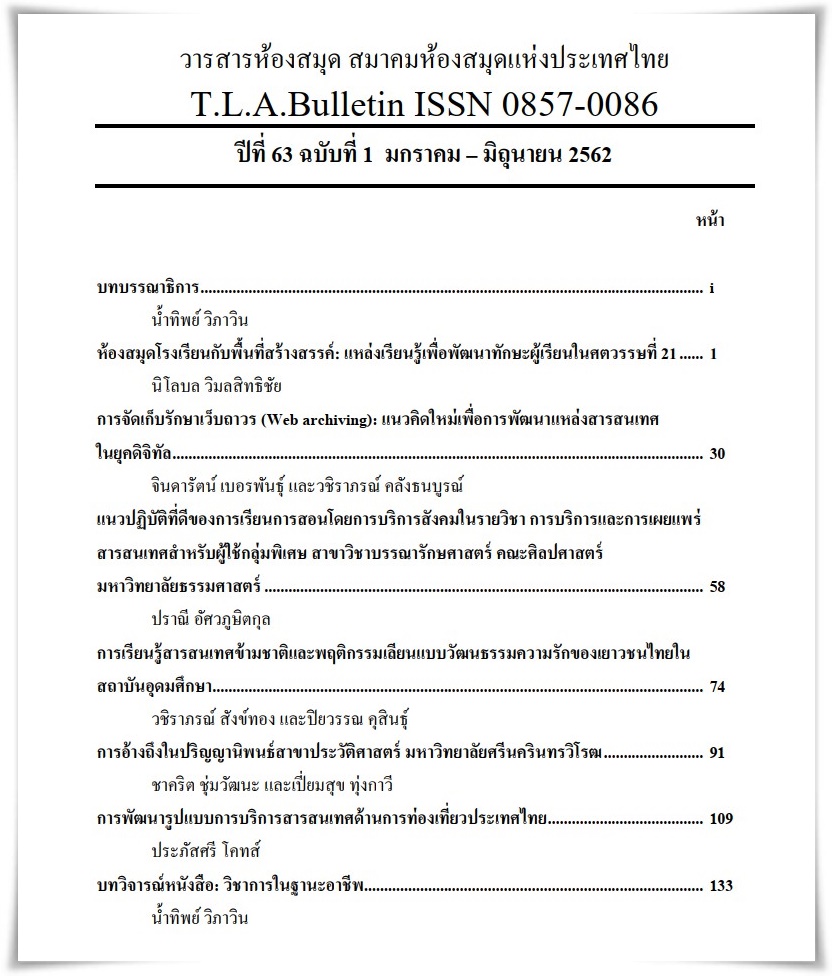การพัฒนารูปแบบการบริการสารสนเทศด้านการท่องเที่ยวประเทศไทย
คำสำคัญ:
การบริการสารสนเทศด้านการท่องเที่ยว, การท่องเที่ยวประเทศไทยบทคัดย่อ
การวิจัยนี้มีวัตถุประสงค์เพื่อ (1) ศึกษาสภาพการบริการสารสนเทศด้านการท่องเที่ยวประเทศไทย (2) ศึกษาแนวปฏิบัติที่ดีของการบริการสารสนเทศด้านการท่องเที่ยวประเทศไทยและต่างประเทศ (3) ศึกษาปัจจัยที่มีผลต่อความสำเร็จของการบริการสารสนเทศด้านการท่องเที่ยวประเทศไทย และ (4) พัฒนารูปแบบการบริการสารสนเทศด้านการท่องเที่ยวประเทศไทย ซึ่งการวิจัยเป็นแบบผสมผสานซึ่งมีกลุ่มตัวอย่างเป็นนักท่องเที่ยวจำนวน 396 คน คัดเลือกแบบง่ายจากจังหวัดที่มีจำนวนนักท่องเที่ยวมากที่สุดและสร้างรายได้สูงทางการท่องเที่ยวตั้งแต่ปี 2554-2558 จำนวน 6 จังหวัด ได้แก่ กรุงเทพมหานคร ชลบุรี กาญจนบุรี ภูเก็ต เชียงใหม่ และนครราชสีมา ผู้บริหารและผู้ปฏิบัติงานจำนวน 18 คน จากการท่องเที่ยวแห่งประเทศไทยและกรมอุทยานแห่งชาติ สัตว์ป่าและพันธุ์พืช จำนวน 6 แห่ง เครื่องมือที่ใช้ในการวิจัยได้แก่ แบบสอบถามและแบบสัมภาษณ์เชิงลึกแบบกึ่งโครงสร้าง สถิติที่ใช้ในการวิเคราะห์ข้อมูลเชิงปริมาณได้แก่ ค่าร้อยละ ค่าเฉลี่ย ส่วนเบี่ยงเบนมาตรฐาน ส่วนการวิเคราะห์ข้อมูลเชิงคุณภาพใช้การวิเคราะห์เนื้อหาแบบอุปนัย
ผลการวิจัยพบว่า (1) สภาพการบริการสารสนเทศด้านการท่องเที่ยวประเทศไทยเป็นการบริการสารสนเทศพื้นฐานแบบเผชิญหน้า ได้แก่ บริการตอบคำถาม บอกเส้นทาง ให้แผนที่ สืบค้นข้อมูลออนไลน์ และการบริการสารสนเทศพิเศษได้แก่ บริการข้อมูลท่องเที่ยวเชิงธุรกิจแก่ผู้ประกอบการ ข้อมูลเฉพาะด้าน และบริการนำส่งเอกสาร มีการบูรณาการความรู้และใช้ทรัพยากรร่วมกันกับหน่วยงานด้านการท่องเที่ยวภาครัฐ เอกชน และท้องถิ่น (2) แนวปฏิบัติที่ดีของการบริการสารสนเทศด้านการท่องเที่ยวประเทศไทยและต่างประเทศ มี 2 ด้านได้แก่ การบริหารจัดการบุคลากรและด้านการบริการสารสนเทศ (3) ปัจจัยที่ส่งผลต่อความสำเร็จของการบริการสารสนเทศด้านการท่องเที่ยวประเทศไทย ได้แก่ การคัดสรรสารสนเทศที่ให้บริการเฉพาะกลุ่ม โครงสร้างพื้นฐานทางเทคโนโลยีสารสนเทศ งบประมาณที่ใช้จ้างบุคลากร ภาวะผู้นำของผู้บริหาร และการมีส่วนร่วมของผู้มีส่วนได้เสีย และ (4) รูปแบบการบริการสารสนเทศด้านการท่องเที่ยวที่เหมาะสมกับประเทศไทยคือ โมเดล SI-IS ประกอบด้วย SI ได้แก่ Sharing (S) การใช้ทรัพยากรร่วมกันและการบูรณาการความรู้ของบุคลากรขององค์กรท่องเที่ยวและชุมชนในท้องถิ่น และ Information (I) สารสนเทศเฉพาะกลุ่มซึ่งเป็นหัวใจสำคัญของการบริการสารสนเทศด้านการท่องเที่ยว Information Systems (IS) ระบบสารสนเทศด้านการท่องเที่ยว ประกอบด้วย ระบบการท่องเที่ยวอัจฉริยะ การเชื่อมโยงบริการสารสนเทศแบบจุดเดียวเบ็ดเสร็จ และมาตรฐานข้อมูลท่องเที่ยวทั่วไทย
Downloads
References
Alberta Government. (2017). A New Visitor Services Model for Alberta Engaging Visitors in an Era of Technology. Retrieved from URL: http://www.culturetourism.alberta.ca/tourism/programs-and-services/visitor-services/avs-model-innovation-fund/docs/visitor-services-model.pdf.
Australian Government. (2017). National Long Term Tourism Strategy. Tourism 2020. Department of Resources, Energy and Tourism. Retrieved from URL: http://www.tourism.australia.com/en/about/our-organisation/our-performance-and-reporting/tourism-2020.html.
Barclays. (2017). Destination UK Driving growth in the UK hospitality and leisure sector. Retrieved from URL: https://www.home.barclays/content/dam/barclayspublic/docs/BarclaysNews/2017/Apr/Tourism%20Report%202017%20digital%2026.04.17.pdf.
Benckendorff P, Sheldon P, & Fesenmaier D. (2014). Introduction to Tourism and Information Technology. Sisscen C.(Ed.). Tourism Information Technology 2nd Edition. London: Gutenberg Press, Malta Chapter 1, 1-11.
Department of Tourism. (2012). Tourism Information Standard. Retrieved from URL: http://www.ratchakitcha.soc.go.th/DATA/PDF/2555/E/151/20.PDF
Great Britain. (2015). Backing the Tourism Sector: A Five Point Plan. Retrieved from URL: https://www.gov.uk/government/ uploads/system/uploads/attachment_data/file/446167/Tourism_-_A_Five_Point_Plan.pdf.
International Standard Organization (2014). Tourist Information and reception services requirements: Retrieved from URL: https://www.iso.org/files/live/sites/isoorg/files/archive/pdf/en/iso-55038-colour.pdf
Ivanov, Stanislav & Webster, Craig. (2012). Tourism’s Impact on Growth: The Role of Globalisation. Annals of Tourism Research, 41. https://doi.org/10.1016/j.annals.2012.12.008.
Karanasios S, Sellitto C & Burgess S. (2015). Mobile devices and information patterns amongst tourists. Retrieved from URL: http://www.informationr.net/ir/20-1/isic2/isicsp10.html#.W7pOQ2hKjIV.
Landrum H., Prybutok V & Zhang X. (2010). The moderating effect of occupation on the perception of information services quality and success, Computers & Industrial Engineering. 58(1). 133-142 https://doi.org/10.1016/j.cie.2009.09.006
Lescoe-Long M & Bolivar P. (2013). Sampling Strategy and Sample Size for a Quantitative Research Plan: Bioterrorism Preparedness and Response to Brucella species. Retrieved from URL: https://pdfs.semanticscholar.org/ e42e/ad044c12a8188a4bf085619a4f0379ff466f.pdf.
Lyu S. and Hwang J. (2015). Are the days of tourist information centers gone? Effects of the ubiquitous information environment, Tourism Management, 48, 54-63. https://doi.org/10.1016/j.tourman.2014.11.001
Mahdayani W. (2011). Visitor Management for Ecotourism Development at World Heritage Site. Retrieved from URL: https://khaoyai.files.wordpress.com/2011/08/visitormanagementatkhaoyainationalpark-wiwikmahdayanidesma.pdf.
Marine-Roig and Clav S. A. , 2015. Tourism analytics with massive user-generated content: A case study of Barcelona. Journal of Destination Marketing and Management. 4. 162-172. https://doi.org/10.1016/j.jdmm.2015.06.004.
No E. & Kim K. (2015). Comparing the attributes of online tourism information sources, Computers in Human Behavior, 50, 564-575, https://doi.org/10.1016/j.chb.2015.02.063.
Park, H. (2013). Task model and task ontology based on mobile users' generic activities for task-oriented tourist information service. International Journal of Smart Home, 7, 33-44.
Pierce, M and Madden, K. (2015). Driving success human resources and sustainable development, Delicated to make a diffirence. Retrieved from URL: http://www.cisl.cam.ac.uk/publications/publication-pdfs/hr-briefing.pdf.
Porntip Suporn, Supansa Rakruk & Pariwat Somnuk. (2013). Guidelines for the One-Stop Tourism Information Service Center Establishment of Nakhon Phanom Province. Retrieved from URL: https://www.tci-thaijo.org/index.php/human_ubu/article/view/85405.
Ratirot, Inkum. (2014). Measuring Service Quality of Tourism Information Center at Suvarnabhumi Airport, International Thai Tourism Journal, 10(1), 59-71
Ruzzene, M., Dunn F. & Ainsaar T. (2013). Victorian Visitor Information Centres Futures Project. http://www.colacotway.vic.gov.au/files/assets/public/trimfiles/council-and-the-shire/tourism- victoria/visitor-information-centres-vic-futures-project-final-report-20131204.pdf.
Somero, M. (2012). Helsinki City Tourist Information in the near future: The expectations of the stakeholders. Retrieved from URL: http://www.theseus.fi/handle/10024/51919.
Standard Australia. (2017). What is Standard?. Retrieved from URL: https://www.standards.org.au/standards-development/what-is-standard.
Tongco M. (2007). Purposive Sampling as a Tool for Informant Selection. Ethnobotany Research And Applications, 5, 147-158. Retrieved from URL: http://journals.sfu.ca/era/index.php/era/article/view/126
Tourism Research Australia. (2015). The influence of Western Australia Visitor Information Center on Tourist Behavior. Tourism Research Australia: TRA. Retrieved from URL: https://www.tra.gov.au/ArticleDocuments/185/THE_INFLUENCE_OF_WESTERN_AUSTRALIAN_VISITOR.
VisitBritain. (2016). The Tourism Action Plan. Welcome to GreatBritain. Retrieved from URL: https://assets.publishing.service.gov.uk/government/uploads/system/uploads/attachment_data/file/555039/Tourism_Action_Plan.pdf
Zsarnoczky, M. (2018). The Digital Future of the Tourism & Hospitality Industry. Boston Hospitality Review. 6. Retrieved from URL: https://www.researchgate.net/publication/325989297_The_Digital_Future_of_the_Tourism_Hospitality_Industry




